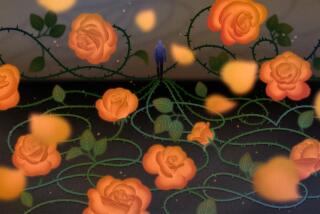How Natalie Erika James turned personal pain into the resonant horror of ‘Relic’
Co-writer and director Natalie Erika James makes her feature debut with “Relic,” a horror film about the inevitability of death and decline.
Natalie Erika James’ atmospheric thriller “Relic” is a film about inevitable and universal horrors.
Robyn Nevin, Emily Mortimer and Bella Heathcote star as three generations of adult women grappling with matriarch Edna’s (Nevin) encroaching Alzheimer’s. The film, which is available now on video on demand and in select theaters (after an exclusive week at drive-ins), explores themes of mental and physical decline, abandonment fears and the cyclical nature of caregiving.
“Both as a mother and a daughter, I feel there’s a lot of guilt, confusion and regret that goes along with being a caregiver,” said Mortimer, who plays Edna’s daughter Kay. “You always feel like you’ve given so much but you never feel like you’ve given enough. And I think that’s really brilliantly expressed in the film as part of that process.”
The movie, which debuted to critical acclaim at Sundance in January, marks the Australian writer and director’s feature debut. The Times caught up with James in advance of the film’s digital release to discuss the nexus of the idea, its similarity to vanitas paintings and the unexpected ways life imitates art.
What inspired you to write this story?
It came from a really personal place. My grandmother, who lived in Japan, had Alzheimer’s and I had taken a trip to go see her. She’d suffered from Alzheimer’s for some time and it was quite a slow decline, but that particular trip was the first time she couldn’t remember who I was. And it really had a deep impact on me because it’s obviously heartbreaking when someone who’s only ever looked at you with love is looking at you like a stranger. I felt a lot of guilt and regret at not having gone to see her more often.
She’d lived in this traditional Japanese house that was probably 100-150 years old. I spent most of my summers there and it used to really freak me out as a kid. Especially because there was a lot of clutter in the upstairs rooms. It was one of those houses with the sliding closet spaces that kind of feel like small rooms in themselves. So I think a combination of those things was really the starting point for the idea.
What attracts you to the horror genre?
Probably the primal elements and how it affects you on an adrenal level. As a preteen and teenager, I’d always loved Asian horror. I think the first film I saw without parental supervision but with a bunch of friends was “The Others.” And it terrified me so much, but there is such a thrill and joy in experiencing that with a group of people. It’s not dissimilar to being on a roller-coaster ride.
I used to have a lot of nightmares as a kid as well. I had a lot of sleep paralysis too, so I was very used to seeing scary imagery. I’ve known I’ve wanted to be a director since I was 13 but I never really [planned for] horror specifically or genre movies. I was more drawn to very dark, psychological dramas. So when I went to film school that’s where I started but slowly over time the stories had more horror elements emerging in them. Horror is the perfect vehicle to talk about fear.
There’s something inherently feminine about the concept of caregiving and the relationships between mothers and daughters in particular. What made those ideas ripe for the horror treatment?
Caregiving often falls on women. For me, the three women came naturally because it was my mother’s mother [who had Alzheimer’s] so those three generations were already present in my life. But we did initially have [male characters]. I think Kay had a husband way back in the first draft and there was a brother [character]. But over the course of development we really stripped that back and decided to focus on just the three women.
I kind of like to think of the film as a vanitas painting in that vanitas art really focuses on motifs of the brevity of life and the inevitability of death. In some ways you can interpret the film as watching a woman in each stage of her life and that’s backed up by the cyclical nature of aging and having children and growing old, having to care for them and then having them care for you. So it felt aesthetically and analytically appropriate.

The characters spend most of their time trapped in a house while a mysterious illness goes around. How does it feel to have inadvertently tapped into what’s going on globally with the pandemic?
[Laughs] Yeah, I never could have guessed. We end on such an emotional note and it really is about the importance of human connection that actually feels all the more resonant because of this time. In terms of isolation, there’s this element of being physically stuck. In a sense the characters are really tied to the house in their love for Edna. And for Edna, [the house] is representative of everything that she has had in her life, all the happy times and everything she has lost. You really acutely feel the elements of the house that have fallen into decline and how much it hints at happier times. So I think there’s a lot tied up in being isolated or trapped and stuck in that sense as well.
While many films have had to skip theatrical releases altogether, this one is playing in select theaters and in drive-ins where IFC has had some success releasing another horror movie, “The Wretched.” How do you feel about the format and about the theatrical experience in general?
I think there’s always something really nice about seeing a horror film in the darkness of the cinema. There’s something brilliant about the communal experience and having to go through it with a group of people. I think IFC has done a tremendous job with turning a completely unpredictable situation into this really wonderful opportunity and I’m thrilled that it’s being shown at drive-ins. Mostly because of the sheer novelty of it, I don’t think we have half as many drive-ins in Australia. The only downside is that we didn’t anticipate it would be shown at drive-ins so we didn’t do any sort of drive-in grade. So I hope that things are still visible because it’s a very dark film intentionally.
More to Read
Only good movies
Get the Indie Focus newsletter, Mark Olsen's weekly guide to the world of cinema.
You may occasionally receive promotional content from the Los Angeles Times.











